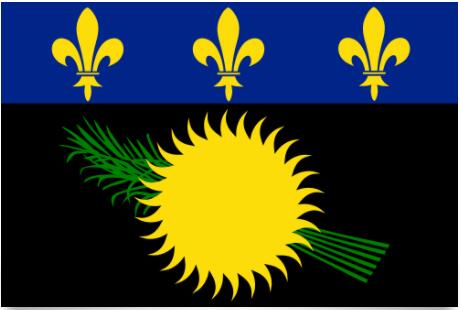Guadeloupe Flag and Meaning
Flag of Guadeloupe

Guadeloupe Flag Meaning
Guadeloupe Overview
| Population | 450000 |
| Currency | Euro |
| Area | 1.710 km² |
| Capital city | Lower Terre |
| Population density | 263.1 residents/km² |
In addition to the main island of Guadeloupe, the department of Guadeloupe consists of Marie-Galante, Désirade, Les Saintes, Petite-Terre, St. Barthelemy and the French part of St. Martin, located in the central and northern part of the small Antilles in the Caribbean. Guadeloupe has volcanic origin and is mountainous. This is especially true of Basse-Terre, where there is an active volcano. The climate is tropical, rainy but moderated by the surrounding sea. Its fertile soils have historically made it suitable for the production of sugar cane. The mountains are covered with dense forest, which is cut down a little on moss and sheep.
The people: The majority of the population is of African origin. Among the European minority there are descendants of Norman and Breton fishermen. This is especially true of the small islands attached to Guadeloupe. In addition, immigrants from Lebanon, China and India (5%).
Religion: Predominantly Catholic
Languages: French (official), Creole
Political parties: Partí Socialiste (PS); Agripación pour le Republic (RPR); Union for the Francaise Democracy (UDF). These 3 parties are local branches of the French mother parties. Partí Comuniste de Guadeloupe (Guadeloupe Communist Party, PCG), founded in 1944, since 1988 it has advocated independence as a must be achieved through “democratically decided steps”. A peel from the PCG formed the Partí Progresiste Democratique de Guadeloupe (Guadeloupe Democratic Progress Party, PPDG). The Union Populaire pour le Liberation de Guadeloupe (The Union of Guadeloupe Liberation Union, UPLG) is the largest among the radical groups advocating independence. Aliance Revolutionaire Caribe (Caribbean Revolutionary Alliance, ARC), founded in Point-a-Pitre in 1983, carried out armed operations,
Social organizations: Guadeloupe’s National Organization has 15,000 members. The provincial branch of the French Christian Country Organization has 3,500 members. In addition, CGT and FO have provincial departments on the island.
Official name: Département d’Outre-Mer de la Guadeloupe et Dépendances.
Administrative division: 3 districts and 36 cantons
Capital: Basse-Terre 20,000 in (2003)
Government: In June 2006 Jean-Jacques Brot was appointed prefect of the French government. Parliament consists of a 42-member General Council and a 41-member Regional Council. Guadeloupe has 4 deputies and 2 senators in the French parliament.













































